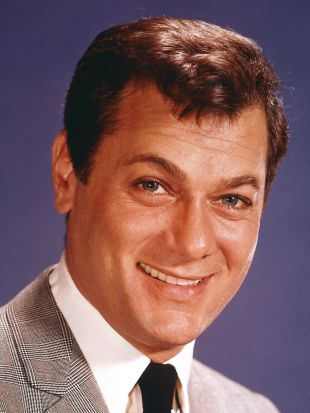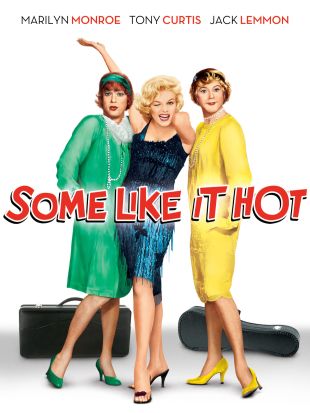Originally dismissed as little more than a pretty boy, Tony Curtis overcame a series of bad reviews and undistinguished pictures to emerge as one of the most successful actors of his era, appearing in a number of the most popular and acclaimed films of the late '50s and early '60s. Born Bernard Schwartz on June 3, 1925, in New York City, he was the son of an impoverished Hungarian-born tailor, and was a member of an infamous area street gang by the age of 11. During World War II, Curtis served in the navy, and was injured while battling in Guam. After the war, he returned to New York to pursue a career in acting, touring the Borscht circuit before starring in a Greenwich Village revival of Golden Boy. There Curtis came to the attention of Universal, who signed him to a seven-year contract. In 1948, he made his film debut, unbilled, in the classic Robert Siodmak noir Criss Cross. A series of bit roles followed, and he slowly made his way up through the studio's ranks.
While 1950's Kansas Raiders was nominally headlined by Brian Donlevy, Curtis was, for many, the real draw; dark and handsome, he was hugely popular with teens and fan-magazine readers, and his haircut alone was so admired that Universal was receiving upwards of 10,000 letters a week asking for a lock of his hair. There was even a contest, "Win Tony Curtis for a week." Clearly, he was on the brink of stardom and earned top billing in his next picture, 1951's The Prince Who Was a Thief, which co-starred another up-and-comer, Piper Laurie. Despite his surging popularity, however, he still had much to learn about his craft and spent the remainder of the year training in voice, dramatics, and gymnastics. In 1952, Curtis finally returned to the screen as a boxer in Flesh and Fury. Two more pictures with Laurie, No Room for the Groom and Son of Ali Baba, followed. In 1953 Paramount borrowed Curtis to portray Houdini, which cast him opposite his wife, Janet Leigh.
Despite continued -- albeit measured -- box-office success, Curtis was roundly panned by critics for his performances, a problem exacerbated by Universal's reliance on formula filmmaking. Pictures like 1954's Beachhead (a war drama), Johnny Dark (an auto-racing tale), and The Black Shield of Falworth (a medieval saga) were all by-the-numbers products. Finally, in 1956 United Artists borrowed him for the Burt Lancaster vehicle Trapeze; not only was it Curtis' first serious project, but it was also his first true commercial smash, resulting in another long-term Universal package. Still, the studio cast him in low-rent programmers like The Rawhide Years and The Midnight Story, and he was forced to fight executives to loan him out. Lancaster tapped him to co-star in 1957's The Sweet Smell of Success, and the resulting performance won Curtis the best reviews of his career. Similar kudos followed for The Vikings, co-starring Kirk Douglas, and Kings Go Forth, a war story with Frank Sinatra.
In 1958, Curtis and Sidney Poitier starred in Stanley Kramer's social drama The Defiant Ones as a pair of escaped convicts -- one white, the other black, both manacled together -- who must overcome their prejudices in order to survive; their performances earned both men Academy Award nominations (the only such nod of Curtis' career), and was among the most acclaimed and profitable films of the year. He returned to Universal a major star and a much better actor; upon coming back, he first starred in a Blake Edwards comedy, The Perfect Furlough, then made the best film of his career -- 1959's Some Like It Hot, a masterful Billy Wilder comedy which cast him and Jack Lemmon as struggling musicians forced to dress in drag to flee the mob. Curtis next starred with his avowed idol, Cary Grant, in Edwards' comedy Operation Petticoat, another massive hit followed in 1960 by Who Was That Lady? with Leigh and Dean Martin.
For director Stanley Kubrick, Curtis co-starred in the 1960 epic Spartacus, followed a year later by The Great Impostor. He delivered a strong performance in 1961's The Outsider, but the film was drastically edited prior to release and was a box-office disaster. After exiting the Gina Lollobrigida picture Lady L prior to production, Curtis made a brief appearance in John Huston's acclaimed The List of Adrian Messenger before appearing opposite Gregory Peck in Captain Newman, M.D. With second wife Christine Kauffman, he starred in 1964's Wild and Wonderful, which was reported to be his last film for Universal. Curtis then focused almost solely on comedy, including Goodbye Charlie, the big-budget The Great Race, and, with Jerry Lewis, Boeing Boeing. None were successful, and he found his career in dire straits; as a result, he battled long and hard to win the against-type title role in 1968's The Boston Strangler, earning good critical notices.
However, Curtis returned to comedy, again with disappointing results: The 1969 Those Daring Young Men in Their Jaunty Jalopies was the unsuccessful follow-up to the hit Those Magnificent Men in Their Flying Machines, while 1970's Suppose They Gave a War and Nobody Came? found even fewer takers. Curtis then attempted a 1971 television series, The Persuaders, but it lasted barely a season. In 1973, he toured in the play Turtlenecks and appeared in the TV movie The Third Girl on the Left. That summer he announced his retirement from films, but was back onscreen for 1975's Lepke. Curtis also attempted another TV series, McCoy, but it too was unsuccessful. In 1976, he appeared in the all-star drama The Last Tycoon, and published a novel, Kid Cody and Julie Sparrow. In 1978, he was also a regular on the hit series Vega$. Ultimately, the decades to come were no more successful than the 1970s, and although Curtis continued to work prolifically, his projects lacked distinction. Still, he remained a well-liked Hollywood figure, and was also the proud father of actress Jamie Lee Curtis.



